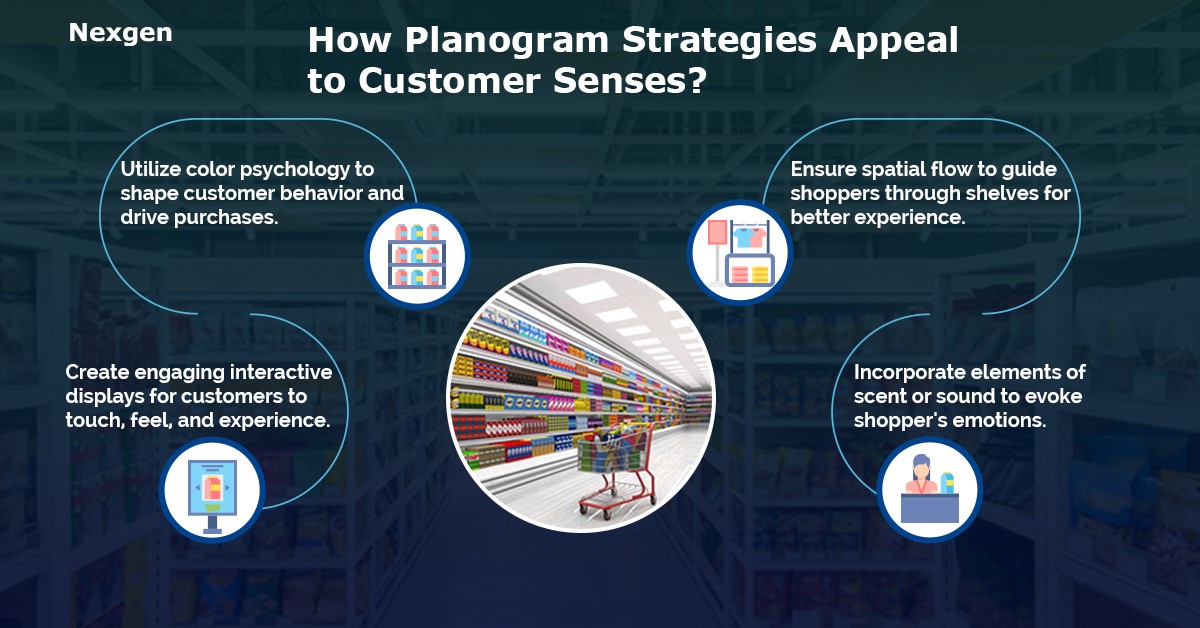Due to the constant necessity to craft unique in-store experiences for shoppers, sensory marketing has gained significant popularity over the past few years due to its ability to provide a point of difference among stores. Recent studies found that human's ability to remember sensory experiences is 1% of what they touch, 2% of how they hear, 5% of what they taste, 15% of what they smell, and 35% of what they see.
Creating emotional connections with customers can influence their purchase behavior. That is why physical stores have an advantage over online stores when it comes to connecting with shoppers using sensory strategies. One such strategy gaining customer attention is sensory retail, a concept that revolves around engaging the customer’s senses to create memorable interactions. At the forefront of this approach lies the art of planogramming – a visual merchandising technique that strategically organizes and displays products within a retail space. This blog will delve into how planogram strategy plays an important role in appealing to customer senses and driving brand engagement.
The Visual Symphony of Planogram Strategy
Planograms, visual representations of how products should be arranged on shelves, are the backbone of effective retail merchandising. Beyond the practical organization of inventory, shelf planning software such as planograms, serve as a powerful tool for retailers to curate a visually enticing environment. Strategic placement of products, thoughtful color schemes, and creative displays can elevate the visual appeal of a store, catching the customer's eye and guiding them through a carefully curated journey.

- Color psychology: Planogram strategies often incorporate color psychology, leveraging the emotional impact of colors to influence customer behavior. Warm tones like red and orange may evoke a sense of urgency or excitement, while cool blues and greens may promote calmness. By aligning the color scheme with the brand's identity and the desired customer experience, retailers can create a visually harmonious and emotionally resonant atmosphere.
- Spatial flow: The shelf layout of a store, meticulously planned through planogramming, contributes to the overall sensory experience. A well-designed spatial flow can guide customers seamlessly through different sections, ensuring they encounter a diverse range of products and experiences. Imagine shoppers passing through the fashion outlets, where the spatial flow takes them through curated displays that showcase the latest trends. The layout is designed to effortlessly transition from casual wear to formal attire, providing a view of the brand’s fashion offerings. This helps shoppers feel the fabrics or try on outfits. This not only maximizes exposure to merchandise but also keeps customers engaged and encourages exploration.
- Interactive displays: Incorporating interactive displays within planograms adds a tactile dimension to the shopping experience. Customers are more likely to engage with products when they can touch, feel, and experience them firsthand. Whether through touch screens, product samples, or hands-on demonstrations, planograms can be designed to invite customers to actively participate in the shopping process. For example, cosmetics stores place interactive displays to bring makeup and skincare products to life. Customers can experiment with different shades of lipstick or eyeshadow through virtual try-ons and receive tips and tutorials on the latest beauty trends. Shoppers can even experience the texture of the skincare products through hands-on demonstrations, making informed decisions about what suits their skin best.
- Aromatherapy and ambient sound: While primarily visual, planograms can extend their influence by incorporating elements of scent and sound. Strategic placement of scent diffusers or the integration of ambient soundscapes can evoke specific emotions, enhance brand identity, and create a multisensory environment that leaves an impression on customers. Imagine that your shopper is surrounded by the calming scent of lavender as they reach the sleep-inducing products placed on shelves. Each scent can be selected thoughtfully to complement the products on display and create a sensory experience for shoppers.
Overview of Nexgen POG
Nexgen POG is a robust and user-friendly cloud-based visual merchandising tool. It is designed for quick and efficient planogramming with minimal effort. Planogram in retail can be designed by easily dragging and dropping the products. The multi-device compatibility feature of POG allows you to obtain, share and edit planogram on any device, including your phone. It helps in designing store-specific planograms for increased product visibility and sales.
Get Your Free Trial Now!